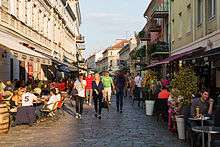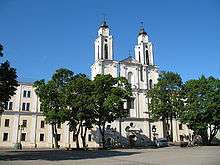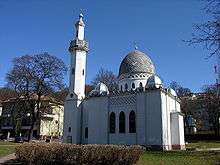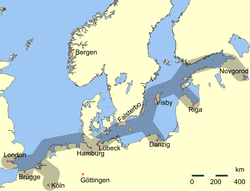Kaunas
| Kaunas | |||||
|---|---|---|---|---|---|
| City | |||||
|
Top to bottom, left to right: Kaunas Castle, House of Perkūnas, Kaunas Town Hall, Kaunas Reservoir, Vytautas the Great War Museum and Church of Saint Michael the Archangel | |||||
| |||||
| Nickname(s): Laikinoji sostinė, Heart of Lithuania | |||||
|
Motto: Diligite justitiam qui judicatis terram (Latin: Cherish justice, you who judge the earth[1]) | |||||
 Location of Kaunas | |||||
| Coordinates: 54°53′50″N 23°53′10″E / 54.89722°N 23.88611°ECoordinates: 54°53′50″N 23°53′10″E / 54.89722°N 23.88611°E | |||||
| Country | Lithuania | ||||
| County | Kaunas County | ||||
| Municipality | Kaunas city municipality | ||||
| Capital of | Kaunas County | ||||
| First mentioned | 1361 | ||||
| Granted city rights | 1408 | ||||
| Elderships | |||||
| Government | |||||
| • Type | City council | ||||
| • Mayor | Visvaldas Matijošaitis | ||||
| Area | |||||
| • City | 157 km2 (61 sq mi) | ||||
| • Metro | 8,089 km2 (3,123 sq mi) | ||||
| Elevation | 48 m (157 ft) | ||||
| Population (2016-01-20) | |||||
| • City | 297,669 | ||||
| • Density | 1,935/km2 (5,010/sq mi) | ||||
| • Metro | 577,221 | ||||
| Time zone | EET (UTC+2) | ||||
| • Summer (DST) | EEST (UTC+3) | ||||
| Postal code | 44xxx - 52xxx | ||||
| Area code(s) | (+370) 37 | ||||
| Vehicle registration | K | ||||
| GDP (nominal), Kaunas county[2] | 2015 | ||||
| - Total | €7.4 billion | ||||
| - Per capita | €12,700 | ||||
| Website | kaunas.lt | ||||
Kaunas (/ˈkaʊnəs/; Lithuanian pronunciation: [ˈkɐʊˑn̪ɐs̪]; also see other names) is the second-largest city in Lithuania and has historically been a leading centre of Lithuanian economic, academic, and cultural life. Kaunas was the biggest city and the centre of a county in Trakai Municipality of the Grand Duchy of Lithuania since 1413. In the Russian Empire it was the capital of the Kaunas Governorate from 1843 to 1915. It became the only temporary capital city in Europe during the interwar period. Now it is the capital of Kaunas County, the seat of the Kaunas city municipality and the Kaunas District Municipality. It is also the seat of the Roman Catholic Archdiocese of Kaunas. Kaunas is located at the confluence of the two largest Lithuanian rivers, the Nemunas and the Neris, and near the Kaunas Reservoir, the largest body of water entirely in Lithuania.
Etymology
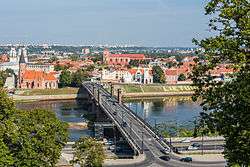
The city's name is of Lithuanian origins and most likely derives from a personal name.[3]
Before Lithuania regained independence, the city was generally known in English as Kovno, the traditional Slavicized form of its name; the Polish name is Kowno; the Belarusian name is Koўнa, Kowna. An earlier Russian name was Ковно Kovno, although Каунас Kaunas has been used since 1940. The Yiddish name is Kovne (קאָװנע), while its names in German include Kaunas and Kauen. The city and its elderates also have names in other languages (see Names of Kaunas in other languages and names of Kaunas elderates in other languages).
Folk history
An old legend claims that Kaunas was established by the Romans in ancient times. These Romans were supposedly led by a patrician named Palemon, who had three sons: Barcus, Kunas and Sperus.[4] Palemon fled from Rome because he feared the mad Emperor Nero. Palemon, his sons and other relatives travelled all the way to Lithuania. After Palemon's death, his sons divided his land. Kunas got the land where Kaunas now stands. He built a fortress near the confluence of the Nemunas and Neris rivers, and the city that grew up there was named after him. There is also a suburban region in the vicinity named "Palemonas".[5]
Coat of arms
On 30 June 1993, the historical coat of arms of Kaunas city was established by a special presidential decree. The coat of arms features a white aurochs with a golden cross between his horns, set against a deep red background. The aurochs is the original heraldic symbol of the city since 1400. The heraldic seal of Kaunas, introduced in the early 15th century during the reign of Grand Duke Vytautas, is the oldest city heraldic seal known in the territory of the Grand Duchy of Lithuania.[6] The current emblem was the result of much study and discussion on the part of the Lithuanian Heraldry Commission, and realized by the artist Raimondas Miknevičius. An aurochs has replaced a wisent, depicted in the Soviet era emblem, used since 1969.
Blazon: Gules, an aurochs passant guardant argent ensigned with a cross Or between his horns.
Kaunas also has greater coat of arms, which is mainly used for Kaunas city representation purposes. Sailer, three golden balls and Latin text "Diligite justitiam qui judicatis terram" (English: Cherish justice, you who judge the earth[1]) in the greater coat of arms is a reference to merchants and seafarers patron Saint Nicholas, who was regarded as a heavenly guardian of Kaunas by Queen Bona Sforza.[7][8]
History
Early history
According to the archeological excavations, the most affluent collections of ceramics and other artifacts found at the confluence of the Nemunas and the Neris rivers are from the second and first millennium BC. During that time people settled in some territories of the present Kaunas: the confluence of the two longest rivers of Lithuania area, Eiguliai, Lampėdžiai, Linkuva, Kaniūkai, Marvelė, Pajiesys, Romainiai, Petrašiūnai, Sargėnai, and Veršvai sites.[9]
Grand Duchy of Lithuania
A settlement had been established on the site of the current Kaunas old town at the confluence of two large rivers, at least by the 10th century AD. Kaunas is first mentioned in written sources in 1361 when brick Kaunas Castle was constructed. In 1362, the castle was captured and destroyed by the Teutonic Order. The commander of the Kaunas castle garrison Vaidotas with 36 men tried to break through, but was taken prisoner. It was one of the largest and important military victories of the Teutonic Knights in the 14th century against Lithuania.[10] The Kaunas castle was rebuilt at the beginning of the 15th century.[11]
In 1408, the town was granted Magdeburg Rights by Vytautas the Great and became a centre of Kaunas Powiat in Trakai Voivodeship in 1413.[12] Vytautas ceded Kaunas the right to own the scales used for weighing the goods brought to the city or packed on site, wax processing, and woolen cloth trimming facilities. The power of the self-governing Kaunas was shared by three interrelated major institutions: vaitas (the Mayor), the Magistrate (12 lay judges and 4 burgomasters) and the so-called Benchers' Court (12 persons). Kaunas then began to gain prominence, since it was at an intersection of trade routes and a river port. In 1441 Kaunas joined the Hanseatic League, and Hansa merchant office Kontor was opened — the only one in the Grand Duchy of Lithuania.[13] By the 16th century, Kaunas also had a public school and a hospital and was one of the best-formed towns in the whole country.[14]
In 1665, the Russian army attacked the city several times, and in 1701 the city was occupied by the Swedish Army. The Black Death struck the area in 1657 and 1708, and fires destroyed parts of the city in 1731 and 1732.[15]
Russian Empire


After the final partition of the Polish–Lithuanian state in 1795, the city was taken over by the Russian Empire and became a part of Vilna Governorate. During the French invasion of Russia in 1812, the Grand Army of Napoleon passed through Kaunas twice, devastating the city both times.[14]
To prevent possible easy access through the city and protect the western borders of Russia the Kovno Fortress was built, still visible throughout the town.[16]
Kovno Governorate, with a centre in Kovno (Kaunas), was formed in 1843. In 1862, a railway connecting the Russian Empire and Imperial Germany was built, making Kaunas a significant railway hub with one of the first railway tunnels in the Empire, completed in 1861. In 1898 the first power plant in Lithuania started operating.[17]
Prior to the Second World War, Kaunas, like many other cities in eastern Europe, had a significant Jewish population. According to the Russian census of 1897, Jews numbered 25,500, 35.3% of the total of 73,500. The population was also 25.8% Russian, 22.7% Polish, 6.6% Lithuanian.[18]
Inter-war Lithuania


After Vilnius was occupied by the Russian Bolsheviks in 1919, the government of the Republic of Lithuania established its main base here. Later, when the capital of Vilnius was forcibly annexed by Poland, Kaunas became the temporary capital of Lithuania,[19] a position it held until 28 October 1939, when the Red Army handed Vilnius back to Lithuania.[20] The Constituent Assembly of Lithuania first met in Kaunas on 15 May 1920. It passed some important laws, particularly on land reform, on the national currency, and adopted a new constitution. The military coup d'état took place in Kaunas on 17 December 1926. It was largely organized by the military and resulted in the replacement of the democratically elected government with a conservative authoritarian government led by Antanas Smetona.[21] The last meeting of the Lithuanian government was held just before midnight in Kaunas on 14 June 1940. During it, the ultimatum presented by the Soviet Union, was debated.
Between the World Wars industry prospered in Kaunas; it was then the largest city in Lithuania. Under direction of the mayor Jonas Vileišis (1921–1931) Kaunas grew rapidly and was extensively modernised. A water and waste water system, costing more than 15 million Lithuanian litas, was put in place, the city expanded from 18 to 40 square kilometres (6.9 to 15.4 sq mi), more than 2,500 buildings were built, plus three modern bridges over the Neris and Nemunas rivers. All the city's streets were paved, horse-drawn transportation was replaced with modern bus lines, new suburbs were planned and built (Žaliakalnis neighbourhood in particular), and new parks and squares were established.[14] The foundations for a social security system were laid, three new schools were built, and new public libraries, including the Vincas Kudirka library, were established. J. Vileišis maintained many contacts in other European cities, and as a result Kaunas was an active participant in European urban life.[22]
During the inter-war period Kaunas had a Jewish population of 35,000–40,000, about one quarter of the city's total population.[23] Jews made up much of the city's commercial, artisan, and professional sectors. Kaunas was a centre of Jewish learning, and the yeshiva in Slobodka (Vilijampolė) was one of Europe's most prestigious institutes of higher Jewish learning. Kaunas had a rich and varied Jewish culture. There were almost 100 Jewish organizations, 40 synagogues, many Yiddish schools, 4 Hebrew high schools, a Jewish hospital, and scores of Jewish-owned businesses. It was also an important Zionist centre.[24]
Soviet occupation
In June 1940, the Soviet Union occupied and annexed Lithuania in accordance with the Molotov–Ribbentrop Pact.[25][26]
Nazi occupation
After the outbreak of German invasion into USSR on 22 June 1941, the June Uprising against the retreating Red Army began in Kaunas and a short-lived period of independence was proclaimed in Kaunas on 23 June 1941.[27] During the battles with the Red Army, Lithuanian rebels secured government offices, police stations, shops, warehouses, and attempted to re-establish order in the city. On 25 June the main German forces marched into the city without opposition and almost in parade fashion. The Nazi Germans did not recognize the new provisional government, but they did not take any actions to dissolve it until the establishment of a German civil administration on 17 July. The government's powers were taken over by the new occupants.[28] Nazi Germany established the Reichskommissariat Ostland in the Baltic States and much of Belarus, and the administrative centre for Lithuania (Generalbezirk Litauen) was in Kaunas ruled by Generalkommissar Adrian von Renteln.[29]

Jewish community of Kaunas
Jews began settling in Kaunas in the second half of the 17th century. They were not allowed to live in the city, so most of them stayed in the Vilijampolė settlement on the right bank of the Neris river. Jewish life in Kaunas was first disrupted when the Soviet Union occupied Lithuania in June 1940. The occupation was accompanied by arrests, confiscations, and the elimination of all free institutions. Jewish community organizations disappeared almost overnight. Soviet authorities confiscated the property of many Jews, while hundreds were exiled to Siberia. Meanwhile, the Lithuanian Activist Front, founded by Lithuanian nationalist émigrés in Berlin, disseminated anti-semitic literature in Lithuania.[23]
Following Hitler's invasion of the Soviet Union on 22 June 1941, Soviet forces fled from Kaunas. Both before and after the German occupation on 25 June, the anti-Communists began to attack Jews, blaming them for the Soviet repressions, especially along Jurbarko and Kriščiukaičio streets.[23] The Lithuanian provisional government established a concentration camp at the Seventh Fortress, one of the city's ten historic forts, and 4,000 Jews were rounded up and murdered there. Prior to the construction of a museum on the site, archaeologists unearthed a mass grave and personal belongings of the Jewish victims.[30] At times Lithuanian Jews were murdered in their homes with unprecedented brutality - slowly sawing off heads or sawing people in two. The Ninth Fortress has been renovated into a memorial for the wars and is the site where nearly 50,000 Lithuanians were killed during Nazi occupation. Of these deaths, over 30,000 were Jews.[31]
Soviet administration



Beginning in 1944, the Red Army began offensives that eventually reoccupied all three of the Baltic states. Kaunas again became the major centre of resistance against the Soviet regime. From the very start of the Lithuanian partisans war, the most important partisan districts were based around Kaunas.[9] Although guerrilla warfare ended at the time of 1953, Lithuanian opposition to Soviet rule did not. In 1956 people in the Kaunas region supported the uprising in Hungary by rioting.[32] On All Souls' Day in 1956, the first public anti-Soviet protest rally took place in Kaunas: citizens burned candles in the Kaunas military cemetery and sang national songs, resulting in clashes with the Militsiya.[9]
On 14 May 1972, 19-year-old Romas Kalanta, having exclaimed "Freedom for Lithuania!", immolated himself in the garden of the Musical Theatre, after making a speech denouncing the Soviet suppression of national and religious rights.[33] The event broke into a politically charged riot, which was forcibly dispersed by the KGB and Militsiya. It led to new forms of resistance: passive resistance all around Lithuania. The continuous oppression of the Catholic Church and its resistance caused the appearance of The Chronicle of the Catholic Church in Lithuania. In strict conspiracy, Catholic priest Sigitas Tamkevičius (now the Archbishop Metropolitan of Kaunas) implemented this idea and its first issue was published in the Alytus district on 19 March 1972. The Kronika started a new phase of resistance in the life of Lithuania's Catholic Church and of all Lithuania fighting against the occupation by making known to the world the violation of the human rights and freedoms in Lithuania for almost two decades.[34] On 1 November 1987, a non-sanctioned rally took place near the Kaunas Cathedral Basilica, where people gathered to mark famous Lithuanian poet Maironis' 125th birthday anniversary. On 10 June 1988, the initiating group of the Kaunas movement of Sąjūdis was formed. On 9 October 1988, the Flag of Lithuania was raised above the tower of the Military Museum.[9] Kaunas, along with Vilnius, became the scene of nearly constant demonstrations as the Lithuanians, embarked on a process of self-discovery. The bodies of Lithuanians who died in Siberian exile were brought back to their homeland for reburial, and the anniversaries of deportations as well as the important dates in Lithuanian history began to be noted with speeches and demonstrations. On 16 February 1989 Cardinal Vincentas Sladkevičius, for the first time, called for the independence of Lithuania in his sermon at the Kaunas Cathedral. After the services, 200,000 persons gathered in the centre of Kaunas to participate in the dedication of a new monument to freedom to replace the monument that had been torn down by the Soviet authorities after World War II.[35]
Restored independence
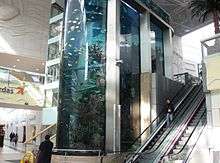


After World War II Kaunas became the main industrial city of Lithuania – it produced about a quarter of Lithuania's industrial output.
After the proclamation of Lithuanian independence in 1990, Soviet attempts to suppress the rebellion focused on the Sitkūnai Radio Station.[36] They were defended by the citizenry of Kaunas.[37] Pope John Paul II made the Holy Mass for the faithful of the Archdiocese of Kaunas at the Kaunas Cathedral Basilica and held the meeting with the young people of Lithuania at S. Darius and S. Girėnas Stadium, during his visit to Lithuania in 1993.[38] Kaunas natives Vytautas Landsbergis and Valdas Adamkus became the Head of state in 1990, and, respectively, in 1998 and 2004. Since the restoration of independence, improving substantially air and land transport links with Western Europe have made Kaunas easily accessible to foreign tourists. Kaunas is famous for its legendary basketball club Žalgiris, which was founded in 1944 and was one of the most popular nonviolent resistance ways during its struggle with the CSKA Moscow. In 2011, the largest indoor arena in the Baltic States was built and was named Žalgiris Arena. Kaunas hosted finals of the widely appreciated EuroBasket 2011.
Geography
The city covers 15,700 hectares. Parks, groves, gardens, nature reserves, and agricultural areas occupy 8,329 hectares.[39]
Administrative divisions
Kaunas is divided into 12 elderates:
Neighbourhoods

The oldest part of Kaunas city is the Old Town located to the east of the confluence of the Nemunas and Neris rivers. The formation of the new rectangular structure of the New Town started in Kaunas since 1847.[40] The construction of the Kaunas Railway Tunnel and Railway Bridge across the Nemunas river helped move goods from the eastern part of Russian Empire west to the German Empire and Kaunas grew rapidly in the second part of the 19th century. The oldest part of Kaunas was connected with Žaliakalnis neighbourhood in 1889. The city increased once more when it was connected by bridges with Aleksotas and Vilijampolė districts in the 1920s.[41]
Climate
Kaunas has a humid continental climate (Köppen climate classification Dfb) with an average annual temperature of approximately 6 °C (43 °F).
Despite its northern location, the climate in Kaunas is relatively mild compared to other locations in similar latitudes, mainly because of the Baltic Sea. Because of its latitude, daylight in Kaunas extends 17 hours in midsummer, to only around 7 hours in midwinter. The Kazlų Rūda Forest,[42] west of Kaunas, create a microclimate around the city, regulating humidity and temperature of the air, and protecting it from strong western winds.
Summers in Kaunas are warm and pleasant with average daytime high temperatures of 21–22 °C (70–72 °F) and lows of around 12 °C (54 °F), but temperatures could reach 30 °C (86 °F) on some days. Winters are relatively cold, and sometimes snowy with average temperatures ranging from −8 to 0 °C (18 to 32 °F), and rarely drop below −15 °C (5 °F). Spring and autumn are generally cool to mild.
| Climate data for Kaunas | |||||||||||||
|---|---|---|---|---|---|---|---|---|---|---|---|---|---|
| Month | Jan | Feb | Mar | Apr | May | Jun | Jul | Aug | Sep | Oct | Nov | Dec | Year |
| Record high °C (°F) | 9.3 (48.7) |
14.8 (58.6) |
20.2 (68.4) |
27.9 (82.2) |
31.4 (88.5) |
32.8 (91) |
34.9 (94.8) |
34.7 (94.5) |
29.7 (85.5) |
23.9 (75) |
16.7 (62.1) |
11.1 (52) |
34.9 (94.8) |
| Average high °C (°F) | −2.6 (27.3) |
−1.4 (29.5) |
3.5 (38.3) |
10.7 (51.3) |
17.9 (64.2) |
21.0 (69.8) |
22.2 (72) |
21.9 (71.4) |
16.7 (62.1) |
10.8 (51.4) |
4.4 (39.9) |
0.0 (32) |
10.4 (50.7) |
| Daily mean °C (°F) | −5.2 (22.6) |
−4.3 (24.3) |
−0.4 (31.3) |
5.8 (42.4) |
12.4 (54.3) |
15.8 (60.4) |
16.9 (62.4) |
16.4 (61.5) |
11.9 (53.4) |
7.1 (44.8) |
1.8 (35.2) |
−2.3 (27.9) |
6.3 (43.3) |
| Average low °C (°F) | −8.5 (16.7) |
−7.6 (18.3) |
−3.6 (25.5) |
1.8 (35.2) |
7.4 (45.3) |
10.9 (51.6) |
12.4 (54.3) |
11.8 (53.2) |
8.1 (46.6) |
4.0 (39.2) |
−0.5 (31.1) |
−4.9 (23.2) |
2.6 (36.7) |
| Record low °C (°F) | −35.8 (−32.4) |
−36.3 (−33.3) |
−26.3 (−15.3) |
−12.0 (10.4) |
−4.9 (23.2) |
−0.2 (31.6) |
4.4 (39.9) |
0.3 (32.5) |
−3.2 (26.2) |
−13.7 (7.3) |
−22.5 (−8.5) |
−28.5 (−19.3) |
−36.3 (−33.3) |
| Average precipitation mm (inches) | 37.7 (1.484) |
29.9 (1.177) |
32.8 (1.291) |
40.5 (1.594) |
49.9 (1.965) |
71.4 (2.811) |
77.3 (3.043) |
81.2 (3.197) |
58.6 (2.307) |
51.3 (2.02) |
48.8 (1.921) |
47.8 (1.882) |
627.0 (24.685) |
| Average precipitation days | 22.3 | 18.6 | 18.6 | 11.3 | 13.4 | 13.2 | 12.1 | 13.0 | 11.3 | 14.0 | 18.8 | 20.9 | 187.5 |
| Average relative humidity (%) | 88.1 | 85.8 | 81.3 | 68.8 | 69.4 | 72.8 | 75.7 | 76.8 | 80.8 | 85.6 | 90.0 | 89.1 | 80.4 |
| Mean monthly sunshine hours | 40.3 | 67.8 | 127.1 | 174.0 | 251.1 | 264.0 | 257.3 | 238.7 | 159.0 | 99.2 | 42.0 | 27.9 | 1,748.4 |
| Source #1: World Meteorological Organization[43] NOAA (extremes)[44] | |||||||||||||
| Source #2: Hong Kong Observatory (sun only)[45] Weatherbase (precipitation and humidity)[46] | |||||||||||||
Landmarks

Central Kaunas is defined by two pedestrian streets: the 2-km-long Laisvės alėja (Liberty Avenue), a central street of the city, lined by linden trees, and its continuation, Vilnius Street, leading to the oldest part – Old Town of Kaunas. Some of the most prominent features in Kaunas include:
- Kaunas Castle, a 14th-century fortification;
- Vytautas' Church, one of the oldest churches in Lithuania and the oldest in Kaunas;
- St. Gertrude Church in Kaunas;
- Kaunas Cathedral Basilica, the largest Gothic building in Lithuania, with a late Baroque interior;
- St. George's Church, which was rumoured to have been turned into a dance studio during the Soviet Occupation;
- Pažaislis abbey, an impressive complex in Baroque style;
- St. Francis Xavier Church;
- Neo-Byzantine church of St. Michael the Archangel;
- Tomb of the Unknown Soldier, Eternal flame, and Statues of Lithuanian national renaissance figures are located in the Vienybės square in front of the War museum;
- Christ’s Resurrection Church with an unfolding panoramic view of the city;
- Kaunas Zoo, the only state-operated zoo in Lithuania;
- Kaunas Fortress, one of the largest defensive structures in Europe, occupying 65 km2 (25 sq mi), a 19–20th century military fortress, which includes a Holocaust site of the Ninth Fort;
- Kaunas Botanical Garden;
- Napoleon's Hill;
- Kaunas Synagogue;
- House of Perkūnas;
- Kaunas Town Hall and the square;
- Interbellum functionalism architecture complexes;
- Two funiculars – Žaliakalnis Funicular Railway and the Aleksotas Funicular Railway;
- Kaunas Mosque;
- Ąžuolynas Park and the valley of Girstupis River named after Adam Mickiewicz;
- Memorial Petrašiūnai Cemetery;
- Lithuanian open-air Ethnographic Museum displaying the heritage of Lithuanian rural life in a vast collection of authentic resurrected buildings is situated east of Kaunas on the bank of Kaunas Reservoir in a town of Rumšiškės;
- Kaunas University of Medicine Hospital;
- Kaunas Cultural Centre of Various Nations;
- Marine aquarium in the Mega Shopping mall.[47]
Museums
_sculpture_in_Kaunas.jpg)
Kaunas is often called a city of museums, because of the abundance and variety of them. The museums in Kaunas include:
- the War Museum of Vytautas the Great;
- the M. K. Čiurlionis National Art Museum, commemorating the work of the early 20th century avant-garde artist M. K. Čiurlionis who sought to combine painting and music into a single artistic medium;
- the Žmuidzinavičius Museum (best known as the Devils' Museum), which houses a collection of more than two thousand sculptures and carvings of devils from all over the world, most of them of folk provenance. Of particular interest are the Adolf Hitler and Joseph Stalin devils, together doing the dance of death over a playground littered with human bones;
- Lithuanian Aviation Museum;
- Museum of the History of Lithuanian Medicine and Pharmacy;
- Historical Presidential Palace, displaying exhibits from the interwar period
- Kaunas Museum for the Blind;
- Povilas Stulga Museum of Lithuanian Folk Instruments;
- Tadas Ivanauskas Zoological Museum;
- Sugihara house-museum;
- Communication History Museum;
- The so-called ab underground printing house was a part of the nonviolent resistance press during the Soviet times. Now it is the branch of Kaunas War Museum, located 8 km (5 mi) north of Kaunas in a small Saliu village, near the town of Domeikava. Although the AB printing house worked regularly, it was never detected by KGB.[48] It was included into the Registry of Immovable Cultural Heritage Sites of Lithuania in 1999.[49]
- The apartments of some famous Kaunas natives, including Paulius Galaunė, Adam Mickiewicz, Juozas Grušas, Balys Sruoga, Juozas Tumas-Vaižgantas, Salomėja Nėris, Juozas Zikaras, Vincentas Sladkevičius have been turned into public museums.[50]
Theatres
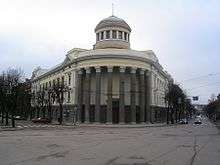
Kaunas is notable for the diverse culture life. Kaunas Symphony Orchestra is the main venue for classical music concerts. There is an old circus tradition in Kaunas. There was established static circus in the Vytautas park of Kaunas in the beginning of the 19th century. The only professional circus organisation in Lithuania – Baltic Circus was founded in Kaunas in 1995.[51] Kaunas theatres has played an important role in Lithuanian society. There are at least 7 professional theatres, lots of amateur theatres, ensembles, abundant groups of art and sports. Some of the best examples of culture life in Kaunas are theatres of various styles:
- Kaunas State Drama Theatre
- Kaunas State Musical Theatre
- Kaunas Pantomime Theatre
- Kaunas Chamber Theatre
- Kaunas Dance Theatre Aura
- Kaunas State Puppet Theatre
Parks and cemeteries
The city of Kaunas has a number of parks and public open spaces. It devotes 7.3% of its total land acreage to parkland.[52] Ąžuolynas (literally, "Oak Grove") park is a main public park in the heart of Kaunas. It covers about 63 hectares and is the largest urban stand of mature oaks in Europe. To protect the unique lower landscape of Kaunas Reservoir, its natural ecosystem, and cultural heritage Kaunas Reservoir Regional Park was established in the eastern edge of Kaunas in 1992. By the initiative of a prominent Lithuanian zoologist Tadas Ivanauskas and biologist Konstantinas Regelis the Kaunas Botanical Garden was founded in 1923. It serves not only as a recreational area for public, but also serves as a showcase for local plant life, and houses various research facilities.
Lithuania's premiere last resting place formally designated for graves of people influential in national history, politics, and arts is Petrašiūnai Cemetery in Kaunas. It is also the burial site of some signatories of the 1918 Act of Independence. There are four old Jewish cemeteries within city limits.
Economy
Kaunas is a large centre of industry, trade and services in Lithuania. The most developed industries in Kaunas are: food and beverage industry, textile and light industry, chemical industry, publishing and processing, pharmaceuticals, metal industry, wood processing and furniture industry. Recently information technology and electronics have become an important area of business activities in Kaunas. The city also has large construction industry, including commercial, housing and road construction.[53]
Primary foreign investors in Kaunas are companies from the United States, Finland, Estonia, Denmark, and Russia.[54] Head offices of several major International and Lithuanian companies are located in Kaunas, including "Kraft Foods Lietuva", largest Generic Pharmaceuticals producer in Lithuania "Sanitas", producer of sportswear AB "Audimas", one of the largest construction companies "YIT Kausta", JSC "Senukai", largest producer in Lithuania of strong alcoholic drinks JSC "Stumbras", Finnish capital brewery JSC "Ragutis", JSC "Fazer Gardesis", JSC "Stora Enso Packaging",[55] producer of pharmaceuticals, and the only producer of homoeopathic medicines in Lithuania JSC "Aconitum".[56] Due to its geographic location, Kaunas is considered one of the biggest logistics centres in Lithuania. The largest wholesale, distribution and logistics company in Lithuania and Latvia JSC "Sanitex",[57] as well as a subsidiary of material handling and logistics company Dematic in the Baltics[58] have been operated in Kaunas. Currently, the feasibility study for Kaunas Public Logistics Centre is being prepared by the national state-owned railway company Lithuanian Railways.[59] The "Margasmiltė" company currently has been working on a project that concerns exploitation of Pagiriai anhydrite deposit. The project includes mining of anhydrite, a mine with underground warehouses, building the overground transport terminal, as well as an administrative building. The Pagiriai anhydrite deposit is located 10.5 km (6.5 mi) south from the downtown of Kaunas, at a 2.2 km (1.4 mi) distance to the southwest from the Garliava town. The resources of thoroughly explored anhydrite in the Pagiriai deposit amount to 81.5 million tons.[60]
The "UBIG group" (a branch of commercial Ūkio bank) is a management company of diversified holdings that operates in the property development, banking, aluminium, mining, logistics, textiles, sports, financial intermediary, and other sectors. The Lithuanian Central Credit Union – national cooperative federation for credit unions established in 2001, is located in Kaunas. At present the Lithuanian Central Credit Union has 61 members.[61]
There are also some innovative companies located in Kaunas, such as leading wholesaler of computer components, data storage media "ACME group", internet and TV provider, communications JSC "Mikrovisata group", developer and producer original products for TV and embedded technologies JSC "Selteka". Joint Lithuanian-German company "Net Frequency", based in Kaunas, is a multimedia and technology service provider. Kaunas is also home to JSC "Baltijos Programinė Įranga", a subsidiary of No Magic, Inc., producing world-leading software modeling tools. A LED lighting assembly plant was opened in Kaunas by South Korean company LK Technology in February 2011.[62] JSC "Baltic car equipment" is one of the leaders in Baltic countries, in the field of manufacturing electronic equipment for automobiles. It also specialises in development of new telemetry, data base creation, mobile payment projects.[63] Kaunas Free Economic Zone[64] established in 1996 has also attracted some investors from abroad, including the development of the new 200 MW Cogeneration Power Plant project, proposed by the Finnish capital company Fortum Heat Lithuania.[65] Before its disestablishment, Air Lithuania had its head office in Kaunas.[66] Kaunas Hydroelectric Power Plant is the largest one in Lithuania.
Some notable changes are under construction and in the stage of disputes. The construction of a new landmark of Kaunas – the Žalgiris Arena – began in the autumn of 2008.[67] It was completed in August 2011. Currently discussions are underway about the further development of the Vilijampolė district on the right bank of the Neris river and the Nemunas River, near their confluence.[68]
Demography


1897 Russian census revealed the following ethnic composition in the city (by mother tongue, out of 70,920):[69]
- Jews 25,052 – 35%
- Russians 18,308 – 26%
- Poles 16,112 – 23%
- Lithuanians 4,092 – 6%
- Germans 3,340 – 4.5%
- Tatar 1,084 – 1.5%
- Other 2932 – 4%
In 1926 the total population of the city was 98,918 with
- Jews 29,427 – 31.8%
- Poles 29,104 – 31.48%
- Lithuanians 27,669 – 29.92%
- Germans 4,164 – 4.51%
- Russians 2,082 – 2.26%.[70]
Today, with almost 94% of its citizens being ethnic Lithuanians, Kaunas is one of the most Lithuanian cities in the country.
Ethnic composition in 2011, out of a total of 315,933:[71]
- Lithuanians – 93.6%
- Russians – 3.8%
- Ukrainians – 0.4%
- Poles – 0.4%
- Belarusians – 0.2%
- Other – 1.6%
Municipality council
.jpg)
Kaunas city municipality council is the governing body of the Kaunas city municipality. It is responsible for municipality laws. The council is composed of 41 member elected for four-year terms.
The council is the member of The Association of Local Authorities in Lithuania.
Mayors
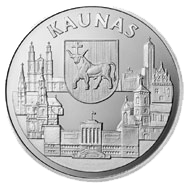
- 1921–1931 – Jonas Vileišis
- 1931 – Juozas Vokietaitis
- 1932–1933 – Antanas Gravrogkas
- 1933–1939 – Antanas Merkys
- 1940 – Antanas Garmus
- 1990–1991 – Vidmantas Adomonis
- 1991–1992 – Vilimas Čiurinskas
- 1992–1995 – Arimantas Račkauskas
- 1995 – Rimantas Tumosa
- 1995–1997 – Vladas Katkevičius
- 1997 – Alfonsas Andriuškevičius
- 1997–2000 – Henrikas Tamulis
- 2000 – Vytautas Šustauskas
- 2000 – Gediminas Budnikas
- 2001–2002 – Erikas Tamašauskas
- 2002–2003 – Giedrius Donatas Ašmys
- 2003–2007 – Arvydas Garbaravičius
- 2007–2011 – Andrius Kupčinskas
- 2011 – Rimantas Mikaitis
- 2011 – 2015 Andrius Kupčinskas
- 2015- Visvaldas Matijošaitis
Transportation
Airports
Kaunas International Airport (KUN) is one of the biggest airports in the Baltic states. In 2010 it handled 809,732 passengers and 4,449 tonnes of cargo. An Irish low-cost airline Ryanair announced Kaunas Airport as their 40th base and first in the Central Europe in February 2010.[72] Kaunas Airport was the fastest growing airport in the Baltic states in 2009 and 2010. The smaller S. Darius and S. Girėnas Airport, established in 1915, is located about three kilometres (1.9 miles) south of the city centre. It is one of the oldest still functioning airports in Europe used for tourism and air sports purposes and now hosts the Lithuanian Aviation Museum.
Highways
Kaunas is served by a number of major motorways. European route E67 is a highway running from Prague in the Czech Republic to Helsinki in Finland by way of Poland, Kaunas Lithuania, Riga (Latvia), and Tallinn (Estonia). It is known as the Via Baltica between Warsaw and Tallinn, a distance of 670 km (416 mi). It is the most important road connection between the Baltic states. Kaunas also is linked to Vilnius to its east and Klaipėda, on the Baltic Sea, via the A1 motorway and Daugavpils (Latvia), via E262(A6) highway.
Bridges
Since Kaunas is located at the confluence of two rivers, there were 34 bridges and viaducts built in the city at the end of 2007, including:
- Vytautas the Great Bridge, connecting Old Town with Aleksotas across the Nemunas;
- M. K. Čiurlionis Bridge, an automotive bridge across the Nemunas;
- Lampėdžiai Bridge across the Nemunas that serves as western bypass of Kaunas;
- Petras Vileišis Bridge, connecting Old Town with Vilijampolė across the Neris River;
- Varniai Bridge, connecting Žaliakalnis with Vilijampolė across the Neris River;
- The Green railway bridge, built in 1862.
Railways
Kaunas is an important railway hub in Lithuania. First railway connection passing through Kaunas was constructed in 1859–1861 and opened in 1862.[73] It consisted of Kaunas Railway Tunnel and the Railway bridge across the Nemunas river. Kaunas Railway Station is an important hub serving direct passenger connections to Vilnius and Warsaw as well as being a transit point of Pan-European corridors I and IX. Some trains run from Vilnius to Šeštokai, and, Poland, through Kaunas. International route connecting Kaliningrad, Russia and Kharkiv, Ukraine, also crosses Kaunas. The first phase of the Standard gauge Rail Baltica railway section from Šeštokai to Kaunas is under construction, and it is expected to be completed by 2013.
Hydrofoil
There used to be a hydrofoil route serving Nida port through Nemunas and across Curonian Lagoon. It has been repeatedly discontinued and reopened, so the most current status is unclear. The company still exists and have its boats in working condition.[74]
Public transportation
The public transportation system is managed by Kauno viešasis transportas (KVT).[75] There are 16 trolleybus routes, 37 bus routes.[76] In 2007 new electronic monthly tickets began to be introduced for public transport in Kaunas. The monthly E-ticket cards may be bought once and might be credited with an appropriate amount of money in various ways including the Internet. Previous paper monthly tickets were in use until August 2009.[77] Kaunas is also one of the major river ports in the Baltic States and has two piers designated for tourism purposes and located on the banks of Nemunas river and Kaunas Reservoir – the largest Lithuanian artificial lake, created in 1959 by damming the Nemunas near Kaunas and Rumšiškės.[78] In 2015, Kauno autobusai bought four Van Hool AGG300 to serve the mostly populated 37th route. These are the longest buses used in the Baltic states.[79]
Sports

Sports in Kaunas have a long and distinguished history. The city is home to a few historic clubs such as: LFLS Kaunas football club (est.1920), LFLS Kaunas baseball club (est.1922), Žalgiris basketball club (est.1944). Ice hockey was first played in Lithuania in 1922. The first Lithuanian ice hockey championship composed of four teams (LFLS, KSK, Kovas, and Macabi) was held in Kaunas, in 1926.[80]
Kaunas is home to some historic venues such as: the main stadium of the city – S.Dariaus ir S.Girėno Sporto Centras (total capacity 9,000), which is also the Lithuanian soccer club FBK Kaunas's and Lithuanian national football team home stadium established in 1923, and Kaunas Sports Hall, completed in 1939 for the Third European Basketball Championship. S.Dariaus and S.Girėno Stadium is also used as the only large athletics stadium in Lithuania.
The university status Lithuanian Academy of Physical Education, founded during the Interwar period, is the only state-supported institution of tertiary physical education in Lithuania. The National Football Academy – the national centre for the training of the best Lithuanian young players of football was established in Kaunas in 2006.
Žalgiris basketball club, one of Europe's strongest basketball clubs, now plays in the Euroleague. Kaunas has also hosted the knockout stage of the European Basketball Championship of 2011. The largest indoor Žalgiris Arena in the Baltics has just been completed in Kaunas. The arena is used to host sports games as well as concerts. The city is also the birthplace or childhood home of many of the country's top basketball stars, among them Arvydas Sabonis, Šarūnas Marčiulionis, Žydrūnas Ilgauskas, Linas Kleiza, Donatas Motiejūnas and Šarūnas Jasikevičius.
Granitas Kaunas is the strongest and most prominent men team handball club in Lithuania. The first golf club "Elnias" in Lithuania was opened in Kaunas in 2000. Nemuno žiedas is the only in Lithuania motor racing circuit, situated in Kačerginė, a small town near Kaunas. A yacht club operates in the Kaunas Reservoir Regional Park.
Education
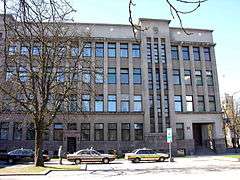

Kaunas is often referred to as a city of students; there are about 50,000 students enrolled in its universities. The first parochial school in Kaunas was mentioned in 1473. A four-form Jesuit school was opened in Kaunas in 1649. It was reorganized into a college in 1653.[81] The oldest still functioning institution of higher education is Kaunas Priest Seminary, established in 1864. Other institutes of higher education are:
- ISM University of Management and Economics – one of the few private institutions of higher education in Lithuania
- Vytautas Magnus University founded in 1922 as the University of Lithuania and renamed Vytautas Magnus in 1930.[82]
- Kaunas Business College
- Kaunas University of Applied Sciences (Kaunas College)
- Lithuanian University of Health Sciences
- Kaunas University of Technology – the largest technical university in the Baltic States
- Lithuanian Sports University
- Aleksandras Stulginskis University
- Vilnius University Kaunas Faculty of Humanities
- Mykolas Romeris University Faculty of Public Security
- Vilnius Academy of Art Kaunas Faculty of Art
- The Santaka Valley - Integrated Science, Studies and Business Centre (Valley)
Kaunas has also a large number of public and private basic and secondary schools, as well as kindergartens and nurseries. Kaunas also has numerous libraries. The most important is the Kaunas County Public Library. It was established as the Central Library of Lithuania in 1919. A part of its collection was transferred to Martynas Mažvydas National Library of Lithuania in 1963.[83] Now the Kaunas County Public Library holds more than 2.2 million volumes in its collection and functions as a depository library of the International Bank for Reconstruction and Development.[84]
Annual events
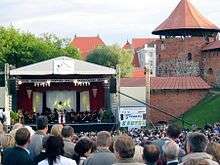
Kaunas is best known for the Kaunas Jazz Festival, International Operetta Festival, Photo Art Festival "Kaunas photo" or Pažaislis music festival, which usually run from early June until late August each year. The open-air concerts of the historical 49-bell Carillon of Kaunas are held on weekends. Probably the longest established festival is the International Modern Dance Festival, which first ran in 1989.
- Kaziukas Fair Kaunas fork (beginning of March)
- International open-air "Kaunas Jazz Festival" (April–May)
- Day of Kaunas city (middle of May)
- Pažaislis music festival (June–August)
- Traditional folk music competition "Play, Jurgelis" (November)
- Christmas tree lighting (end of November)
Notable residents
Twin towns – Sister cities
|
Honours
A minor planet 73059 Kaunas, discovered by Lithuanian astronomers Kazimieras Černis and Justas Zdanavičius, in 2002, is named after the city of Kaunas.[90]
References
- 1 2 Raffa, Guy P. (2009-08-01). The Complete Danteworlds: A Reader's Guide to the Divine Comedy. University of Chicago Press. ISBN 9780226702872.
- ↑ http://osp.stat.gov.lt/en/statistiniu-rodikliu-analize?id=8446&status=A
- ↑ Zinkevičius, Zigmas (2007). Senosios Lietuvos valstybės vardynas. Vilnius: Mokslo ir enciklopedijų leidybos institutas. p. 42. ISBN 5-420-01606-0.
- ↑ Ivinskis, Zenonas (1953–1966). "Palemonas". Lietuvių enciklopedija. 21. Boston, Massachusetts: Lietuvių enciklopedijos leidykla. pp. 400–401. LCC 55020366.
- ↑ "Palemonas.info; Kauno mikrorajonas – Palemonas" (in Lithuanian). Retrieved 13 April 2011.
- ↑ "Kaunas: Dates and Facts. Overview of Kaunas History.". Retrieved 13 October 2016.
- ↑ Tūkstantmečio metų palydose bus pristatytas didysis Kauno herbas (Lithuanian)
- ↑ Kauno miesto savivaldybė - Kauno miesto herbas (Lithuanian)
- 1 2 3 4 "Kaunas: Dates and Facts. Overview of Kaunas History". Retrieved 29 October 2010.
- ↑ Simas Sužiedėlis, ed. (1970–1978). "Vaidotas". Encyclopedia Lituanica. VI. Boston, Massachusetts: Juozas Kapočius. p. 21. LCC 74-114275.
- ↑ http://www.kaunas.lt/index.php?1137823477 Kaunas City Municipality. Places to Visit. Kaunas Castle.
- ↑ Laužikas, Rimvydas (15 October 2004). "Trakų vaivadija". Aruodai (in Lithuanian). Lithuanian Institute of History. Retrieved 22 April 2011.
- ↑ Mills, Jennifer (May 1998). "The Hanseatic League in the Eastern Baltic". Encyclopedia of Baltic History (group research project) . University of Washington.
- 1 2 3 http://datos.kvb.lt/en/index.php?option=com_content&task=view&id=21&Itemid=81 Kaunas: Dates and Facts. Overview of Kaunas History.
- ↑ Kaunas History. Retrieved on 12 April 2011.
- ↑ Kauno tvirtovės istorija (in Lithuanian), Gintaras Česonis, 2004, retrieved 20 March 2011
- ↑ http://www.lpc.lt/en/main/about/short/development AB Lietuvos Energija. Development of Lithuanian Energy Sector.
- ↑ Robert Blobaum, Feliks Dzierzynski and the SDKPIL a study of the origins of Polish Communism, page 42
- ↑ Eidintas, Alfonsas; Vytautas Žalys; Alfred Erich Senn (September 1999). Ed. Edvardas Tuskenis, ed. Lithuania in European Politics: The Years of the First Republic, 1918–1940 (Paperback ed.). New York: St. Martin's Press. pp. 67–70. ISBN 0-312-22458-3.
- ↑ Senn, Alfred Erich (2007). Lithuania 1940: Revolution from Above. On the Boundary of Two Worlds: Identity, Freedom, and Moral Imagination in the Baltics. Rodopi. p. 10. ISBN 90-420-2225-6.
- ↑ Vardys, Vytas Stanley; Judith B. Sedaitis (1997). Lithuania: The Rebel Nation. Westview Series on the Post-Soviet Republics. WestviewPress. pp. 34–36. ISBN 0-8133-1839-4.
- ↑ Dobkevičius, Kazimieras (6 February 2002). "Klojęs Lietuvos valstybės pamatus". XXI amžius (newspaper) (in Lithuanian) (10 (1017)). Retrieved 20 July 2011.
- 1 2 3 "Kovno". Ushmm.org. Retrieved 5 May 2009.
- ↑ http://www.yadvashem.org/yv/en/exhibitions/this_month/resources/kovno.asp
- ↑ I. Žiemele. Baltic Yearbook of International Law, 2001. 2002, Vol.1 p.10
- ↑ K. Dawisha, B. Parrott. The Consolidation of Democracy in East-Central Europe. 1997 p. 293.
- ↑ Bubnys, Arūnas (1998). Vokiečių okupuota Lietuva (1941–1944) (in Lithuanian). Vilnius: Lietuvos tautinis kultūros fondas. p. 35. ISBN 9986-757-12-6.
- ↑ Misiunas, Romuald J.; Rein Taagepera (1993). The Baltic States: Years of Dependence 1940–1990 (expanded ed.). University of California Press. p. 47. ISBN 0-520-08228-1.
- ↑ Kay, Alex J. (2006) Exploitation, Resettlement, Mass Murder: Political and Economic Planning for German Occupation Policy in the Soviet Union, 1940–1941, page 129. Berghahn Books.
- ↑ Trove of everyday items reveals Lithuania's dark Holocaust secret, Haaretz
- ↑ Museum History Fragments, Museums of Lithuania
- ↑ "Lithuanians – History and Cultural Relations". Retrieved 29 October 2010.
- ↑ Vardys, Stanley (Summer 1972). "Protests in Lithuania not Isolated". Lituanus. Retrieved 29 January 2011.
- ↑ "The Chronicle of the Catholic Church in Lithuania. Situation of the Catholic Church in Lithuania in Soviet times.". Retrieved 10 November 2010.
- ↑ Satter, David (Summer 2009). "From a Journalist's Notebook: Vilnius, January 13, 1991". Lituanus. Retrieved 29 January 2011.
- ↑ "Seimas of the Republic of Lithuania. A Chronicle of the Events of January 1991 and Later Months, which were a critical part of the remaining free media". Retrieved 29 January 2011.
- ↑ http://www.toptravel.lt/lithuania/kaunas-facts-history/ Kaunas. Facts&History.
- ↑ "The Holy See: Apostolic journey to Lithuania, Latvia and Estonia (4–10 September 1993)". Holy See. Retrieved 30 October 2009.
- ↑ "Baltic University Programme Urban Forum City Status Report V". Baltic University Programme. Archived from the original on 10 June 2007. Retrieved 25 January 2009.
- ↑ Architecture in Kaunas Retrieved on 1 June 2011.
- ↑ Kaunas: dates and facts. Electronic directory. First Republic of Lithuania Retrieved on 1 September 2011.
- ↑ "Portrait of the Regions of Lithuania; Kazlų Rūda Municipality". Retrieved 6 December 2010.
- ↑ "World Weather Information Service - Kaunas". World Meteorological Organization. May 2011. Retrieved 1 December 2008.
- ↑ "Kaunas Climate Normals 1961-1990". National Oceanic and Atmospheric Administration. Retrieved 2 February 2013.
- ↑ "Climatological Normals of Kaunas". Hong Kong Observatory. Retrieved 14 March 2011.
- ↑ "Weatherbase: Historical Weather for Garliava, Lithuania". Weatherbase. Retrieved 2 February 2013.
- ↑ Mega Shopping and Leisure Centre. Aquarium Retrieved on 31 August 2011.
- ↑ Underground Printing-House "ab" The Branch Museum of Vytautas the Great War Museum Retrieved on 29 April 2011.
- ↑ The Registry of Immovable Cultural Heritage Sites: Unique object code: 24807. Retrieved on 29 April 2011.
- ↑ Museums in Kaunas Retrieved on 9 June 2011.
- ↑ The Baltic Circus Home Page. Retrieved on 29 October 2010
- ↑ "Aplinkos apsauga. Kauno miesto savivaldybė; Kauno miesto želdynų sistemos formavimas" (in Lithuanian). Retrieved 11 December 2010.
- ↑ Kaunas County Governor's Administration Retrieved on 8 April 2011.
- ↑ European Business Guide. Kaunas Retrieved on 8 December 2011.
- ↑ Stora Enso.Kaunas Mill Retrieved on 3 September 2011.
- ↑ Pharmaceutical company "Aconitum" Retrieved on 3 September 2011.
- ↑ Sanitex. Distribution & Logistics Retrieved on 3 September 2011
- ↑ Dematic Europe and South America Retrieved on 10 February 2012
- ↑ UK Trade&Investment. Lithuania – Development of Kaunas Public Logistics Centre Retrieved on 10 February 2012
- ↑ JSC "Margasmiltė". Anhydrite mining Retrieved on 7 December 2011.
- ↑ Lithuanian Central Credit Union Retrieved on 7 December 2011.
- ↑ Koreans open LED lighting assembly plant in Kaunas. Retrieved on 16 March 2011.
- ↑ Baltic Car Equipment. Retrieved on 12 March 2012.
- ↑ Kaunas Free Economic Zone Home page. Retrieved on 25 October 2010.
- ↑ Fortum Heat Lithuania is planning to build a power plant in Kaunas Retrieved on 12 March 2012.
- ↑ "Home page". Air Lithuania. 6 August 2002. Archived from the original on 6 August 2002. Retrieved 15 January 2010.
- ↑ "Kamanė; Blessing to Open Kaunas Arena Facades". Retrieved 17 May 2010.
- ↑ "Kamanė; Exam of New Architecture in Vilijampolė and near Kalniečiai Park". Retrieved 15 December 2009.
- ↑ Первая Всеобщая перепись населения Российской Империи 1897 г. Таблица XIII. Распределение населения по родному языку. Т.Т.1–50. С.-Петербург: 1903–1905
- ↑ Statystyka narodowościowa Litwy Kowieńskiej na podstawie danych głosowania do Sejmów. Opracowana według urzędowych danych statystyki wyborczej przez Centralny Polski Komitet Wyborczy, Drukarnia "Prima"; S-Ka "Omega", Kowno, 1926, p. 13
- ↑ 2011 Census – Lithuanian Government Department of Statistics
- ↑ http://www.ryanair.com/en/news/ryanair-announces-40th-base-at-kaunas-lithuania Ryanair Announces 40th Base at Kaunas (Lithuania)
- ↑ History of Lithuanian Railways. Construction of First Railways. Retrieved on 7 April 2011.
- ↑ http://www.visitlithuania.net/index.php/component/content/article/136-river-transport/602-qrocketq.html
- ↑ "Kauno viešasis transportas (KVT)". KVT. Retrieved 6 March 2011.
- ↑ "Schedules: Buses". Kauno viešasis transportas (KVT). Retrieved 6 March 2011.
- ↑ http://transportas.kaunas.lt/index_en.php?page=160 Kaunas city public transport. General information
- ↑ "Menas valdyti energiją" (PDF) (in Lithuanian). Lietuvos Energija. Retrieved 19 May 2011.
- ↑ Kauno gatvėse – ilgiausias autobusas Baltijos šalyse (Lithuanian)
- ↑ "Elektrėnų sporto, turizmo ir pramogų centras; Ledo ritulys" (in Lithuanian). Retrieved 25 October 2010.
- ↑ http://datos.kvb.lt/en/index.php?option=com_laikotarpiai&task=view&id=18&Itemid=64 Kaunas: Dates and Facts. Kaunas from its Origins to the Fall of Grand Duchy of Lithuania
- ↑
- http://www.vdu.lt/en/simplepages/884/tid/872 – Vytautas Magnus University Now and Before
- ↑ Martynas Mažvydas National Library of Lithuania. Historical Outlines Retrieved on 30 December 2011.
- ↑ Kaunas County Public Library Retrieved on 9 December 2011.
- ↑ Kauno partneriai
- ↑ "City of Brno Foreign Relations - Statutory city of Brno" (in Czech). 2003 City of Brno. Retrieved 6 September 2011. External link in
|publisher=(help) - ↑ "Wrocław Official Website – Partnership Cities of Wrocław".



 (in English, German, French and Polish) [[copyright|]] 2007 Wrocław Municipality. Retrieved 23 October 2008.
(in English, German, French and Polish) [[copyright|]] 2007 Wrocław Municipality. Retrieved 23 October 2008. - ↑ Jérôme Steffenino, Marguerite Masson. "Ville de Grenoble –Coopérations et villes jumelles". Grenoble.fr. Retrieved 16 May 2013.
- ↑ Korolczuk, Dariusz (12 Jan 2010). "Foreign cooperation - Partner Cities". Białystok City Council. City Office in Białystok. Retrieved 2013-03-22.
- ↑ "JPL Small-Body Database Browser". NASA. Retrieved 7 December 2010.
External links
| Wikimedia Commons has media related to Kaunas. |
| Wikisource has the text of the 1911 Encyclopædia Britannica article Kovno (town). |
- Website of Kaunas city
- Tourist Information Centre of Kaunas region
- Kaunas Travel Guide
 Kaunas travel guide from Wikivoyage
Kaunas travel guide from Wikivoyage


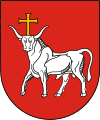





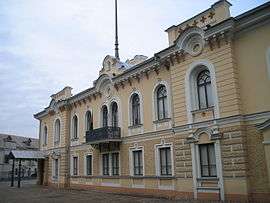

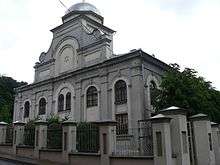
.jpg)
